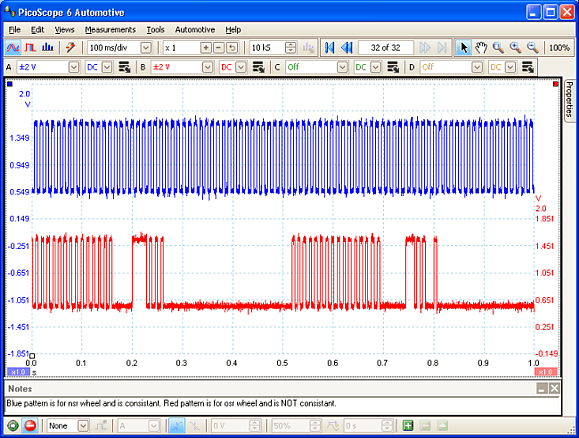BMW Braking Issues
A 2000 model year BMW 5 Series was brought to us with the ABS/ESP light illuminated, following unsuccessful diagnosis and repair elsewhere.
The following diagnosis and repair procedure was carried out:
1. The ABS/ESP system ECU was interrogated with a serial diagnostic platform. A fault was stored indicating a problem with the signal from the OSR wheel speed sensor.
2. The fault code was cleared and the ignition cycled, and the codes re-checked. No fault code was shown, thus proving the integrity of the sensor, the wiring and the ECU.
3. When the vehicle was then driven, the ABS light illuminated within a very short period. The fault memory was re-checked and the same fault code found stored in the ECU memory.
4. The signal output connections from both rear wheel speed sensors were back-probed, with the probes connected to a PicoScope 3423 4-channel oscilloscope. The vehicle was raised on a 2-post lift and the rear wheel driven at low speed. The signal patterns were recorded.
This signal clearly shows intermittent signal output from the OSR wheel speed sensor.

5. The OSR wheel speed sensor was inspected and found to be new.
6. The OSR wheel hub assembly was removed to inspect the sensor ring. Upon initial visual inspection the sensor ring, which forms part of the bearing grease seal, was depressed excessively for approximately 33% of the circumference. This measurement was taken with a vernier depth gauge and found to be outside the manufacturer’s specification.
7. The damaged wheel bearing was replaced and the hub assembly refitted to the vehicle.
8. The ABS/ESP ECU fault codes were cleared. The vehicle was then road-tested. No ABS light was illuminated. The ECU was once again interrogated, and no faults were stored.
9. The conclusion of this diagnosis is that the sensor ring within the wheel bearing assembly was the cause of the fault. The sensor ring had been damaged during assembly of the recently fitted wheel bearing unit. The sensor ring had been distorted causing an excessive air gap between the sensor and the ring, which in turn caused loss of signal output from the sensor and the fault to be recorded by the ECU.
10. The damage to the sensor ring was most likely caused either by the ring being compressed upon installation of the bearing to the hub, or removal and reassembly of the bearing due to incorrect initial fitting of the bearing to the hub. The bearing cannot be refitted once it is removed from the hub.
courtesy of Stuart White - Pico Tech
www.autoequipment.com.au
|



